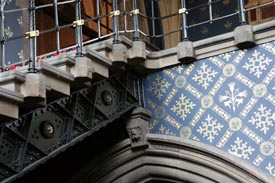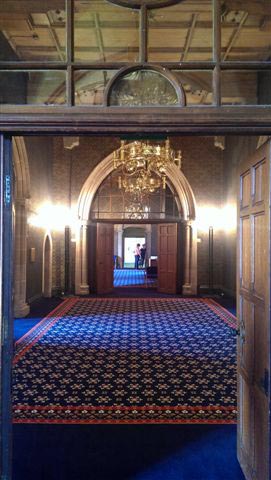South Stair as it was meant to be
Published: 1 September 2014
The refurbishment of the Gilbert Scott building's South Stair, the grand staircase that leads from the Gilbert Scott building ground-floor to the Bute Hall, Senate Room and Principal's Offices, has been completed.
The refurbishment of the Gilbert Scott building's South Stair, the grand staircase that leads from the Gilbert Scott building ground-floor to the Bute Hall, Senate Room and Principal's Offices, has been completed, writes Claire Diamond of the Communications Office.
 After work started in May the stair case has been extensively refurbished to match the ambitions of the 19th century architect.
After work started in May the stair case has been extensively refurbished to match the ambitions of the 19th century architect.
The Estates and Buildings Department, who commissioned the decorative work, consulted with Glasgow City Council and Historic Scotland about the major historical and architectural importance of the staircase.
Professor David Gaimster, Director of the Hunterian, called the refurbishment " a benchmark for the future care of the University's built heritage", continuing: "The South Stair leading to the University's Senate Rooms has just been restored and refurbished in sympathy with its iconic status as a Grade A-listed historic interior and as one of the showpieces of Sir George Gilbert Scott's great Gothic Revival campus.
"As a public space, like the Bute Hall, the South Stair was intended for a highly embellished Gothic decorative scheme, but unfortunately this ambition was never realised.”
Previously the South Stair was hung with portraits of leading figures in University history, but these suffered from water ingress and over exposure to the intense light flooding through the South Front windows over the years.
The South Stair was never intended for the display of  pictures, so the best of these – such as fine portraits of Lord Kelvin and Sir Joseph Lister - will hang in the Hunterian Museum amongst the artefacts and apparatus associated with their great achievements.
pictures, so the best of these – such as fine portraits of Lord Kelvin and Sir Joseph Lister - will hang in the Hunterian Museum amongst the artefacts and apparatus associated with their great achievements.
As part of the work the imposing statue of Adam Smith has been moved and raised in to a more prominent and commanding position.
Professor Gaimster said: "Assisted by Conservation architects Nimmo and Partners, a new visual treatment of the space was developed that would enhance both the heritage value and also the functionality of one of the University' leading ambassadorial spaces.
"Key elements of the new scheme include an authentic Gothic Revival colour scheme decorated with a rich stencil design combining emblems of Scotland and the University and multiple brass chandeliers.
“On the ground floor visitors will note that the old furnishings have been replaced by a Gothic-style timber reception desk and bench seating.”
First published: 1 September 2014
<< September

